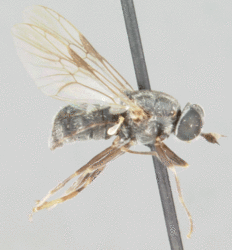Adoxomyia
Keith Bayless- Adoxomyia alashanica
- Adoxomyia albopilosa
- Adoxomyia appressa
- Adoxomyia argentata
- Adoxomyia argenteofasciata
- Adoxomyia aureovittata
- Adoxomyia bistriata
- Adoxomyia brevispina
- Adoxomyia cinerascens
- Adoxomyia claripennis
- Adoxomyia dahlii
- Adoxomyia fenestrata
- Adoxomyia flauipes
- Adoxomyia formosana
- Adoxomyia heminopla
- Adoxomyia hermonensis
- Adoxomyia hungshanensis
- Adoxomyia lata
- Adoxomyia lindneri
- Adoxomyia lugubris
- Adoxomyia marginata
- Adoxomyia micheneri
- Adoxomyia nigribarba
- Adoxomyia obscuripennis
- Adoxomyia palaestinensis
- Adoxomyia pleskei
- Adoxomyia portschinskii
- Adoxomyia regularis
- Adoxomyia ruficornis
- Adoxomyia rustica
- Adoxomyia sarudnyi
- Adoxomyia socotrae
- Adoxomyia subulata
- Adoxomyia taxana
- Adoxomyia tenuicornis
- Adoxomyia transcaucasica
- Adoxomyia weyrauchi
Introduction
Adoxomyia is found in all zoogeographic regions except Australia. It is most diverse in the Palaearctic region. Only 4 species are found in the Neotropical region, 3 in Eastern Asia, and one, A. argenteofasciata, is found in Eastern Subsaharan Africa.
Characteristics
Adoxomyia is distinguished from other Nearctic Clitellariinae by the pilose eyes, unpatterned wings, and the stylate antenna in which the last three flagellomeres are much longer than wide (James 1981).
References
James, M.T. 1981. 36. Stratiomyidae. 1981. Manual of Nearct. Dipt. 1: 497-511.
Woodley, N. E. 2001. A World Catalog of the Stratiomyidae (Insecta: Diptera). Myia 11: 1-473. Backhuys Publishers, Leiden.
Information on the Internet
- Harvard MCZ Type Images. Images of Adoxomyia lata.
- Harvard MCZ Type Images. Images of Adoxomyia rustica.
- Harvard MCZ Type Images. Images of Adoxomyia subulata.
Title Illustrations

| Scientific Name | Adoxomyia subulata |
|---|---|
| Location | Raleigh, North Carolina, USA |
| Specimen Condition | Dead Specimen |
| Life Cycle Stage | Adult |
| View | Lateral |
| Image Use |
 This media file is licensed under the Creative Commons Attribution-NonCommercial License - Version 2.5. This media file is licensed under the Creative Commons Attribution-NonCommercial License - Version 2.5.
|
| Copyright |
© Keith Bayless

|
About This Page
Keith Bayless

North Carolina State University, Raleigh, North Carolina, USA
Correspondence regarding this page should be directed to Keith Bayless at
kmbayles@ncsu.edu
Page copyright © 2008 Keith Bayless
All Rights Reserved.
- First online 28 September 2008
- Content changed 28 September 2008
Citing this page:
Bayless, Keith. 2008. Adoxomyia. Version 28 September 2008 (under construction). http://tolweb.org/Adoxomyia/108709/2008.09.28 in The Tree of Life Web Project, http://tolweb.org/








 Go to quick links
Go to quick search
Go to navigation for this section of the ToL site
Go to detailed links for the ToL site
Go to quick links
Go to quick search
Go to navigation for this section of the ToL site
Go to detailed links for the ToL site